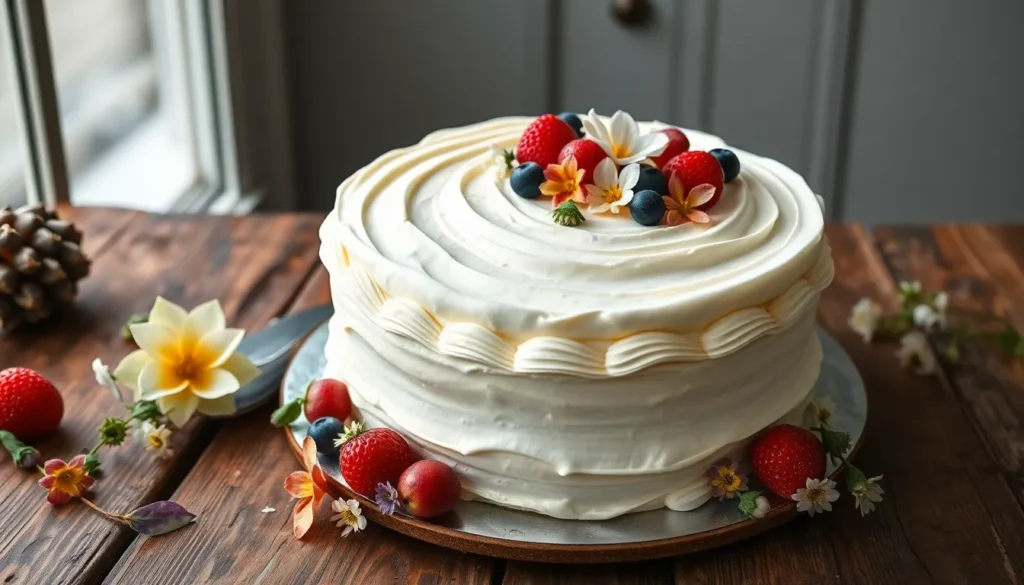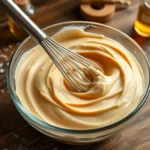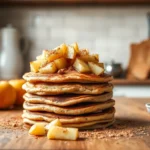We’ve discovered the secret to creating the most luxurious frosting that’ll transform any dessert into a bakery-worthy masterpiece. Mascarpone frosting combines the rich creaminess of Italian mascarpone cheese with powdered sugar to create a velvety smooth topping that’s less sweet than traditional buttercream yet infinitely more decadent.
This sophisticated frosting originated in Italian pastry kitchens where bakers needed something elegant enough for tiramisu but versatile enough for layer cakes. Unlike heavy cream cheese frosting, mascarpone’s delicate flavor won’t overpower your desserts – it enhances them. We love how it pipes beautifully holds its shape and melts perfectly on your tongue.
Whether you’re frosting a vanilla sponge cake decorating cupcakes or filling pastries this foolproof recipe delivers professional results every time. We’ll show you exactly how to achieve that perfect consistency and share our best tips for flavoring variations that’ll make your desserts absolutely irresistible.
What Is Mascarpone Frosting
Mascarpone frosting combines the rich Italian cheese mascarpone with powdered sugar and cream to create an exceptionally smooth and luxurious topping. We consider this frosting the perfect bridge between traditional buttercream and cream cheese frosting, offering a more sophisticated flavor profile than either alternative.
The base ingredient mascarpone provides a naturally creamy texture without the tanginess found in cream cheese frostings. This Italian cheese contains approximately 75% fat content, which creates the signature silky consistency that makes our frosting so appealing. Unlike buttercream that relies heavily on butter and sugar for structure, mascarpone frosting achieves its stability through the cheese’s natural proteins and fats.
We appreciate how this frosting maintains its shape while remaining incredibly smooth and spreadable. The mild flavor profile allows the frosting to complement rather than compete with delicate cake flavors like vanilla, lemon, or berry varieties. Traditional buttercream can sometimes overwhelm subtle dessert flavors, but mascarpone frosting enhances them instead.
Professional bakers often choose mascarpone frosting for its superior piping qualities and elegant appearance. The frosting holds detailed decorative work beautifully while maintaining a clean, sophisticated look on finished desserts. We find it particularly effective for wedding cakes, cupcakes, and layered desserts where presentation matters most.
Temperature plays a crucial role in mascarpone frosting success. The cheese performs best when used at room temperature, creating optimal consistency for mixing and spreading. Cold mascarpone can result in lumpy frosting, while overly warm cheese may cause the mixture to become too loose for proper coverage.
Ingredients

We need just five simple ingredients to create this silky mascarpone frosting that rivals any professional bakery creation. Each component plays a crucial role in achieving the perfect texture and flavor balance.
Essential Ingredients:
- 8 ounces mascarpone cheese – The star ingredient that provides our frosting’s luxurious base and creamy texture
- 2 to 3 cups powdered sugar – Sweetens the frosting while helping it maintain structure and pipeable consistency
- 1 cup heavy whipping cream – Lightens the mixture and creates the perfect spreadable texture
- 1 to 2 teaspoons vanilla extract – Enhances flavor without overpowering the delicate mascarpone taste
- Pinch of salt (optional) – Amplifies all the flavors and balances the sweetness
Preparation Notes:
We recommend using mascarpone cheese at room temperature for optimal mixing results. Cold mascarpone can create lumps that are difficult to smooth out during preparation. Heavy whipping cream should remain chilled until we’re ready to incorporate it into our mixture.
Substitution Options:
When mascarpone isn’t available, we can create an effective substitute using:
- 8 ounces cream cheese (room temperature)
- 2 tablespoons sour cream or Greek yogurt
- 2½ cups heavy cream (increased amount to compensate for texture differences)
This substitution creates a similar consistency though the flavor profile will be slightly tangier than authentic mascarpone frosting. We find this alternative works particularly well for casual home baking when mascarpone proves difficult to source.
Equipment Needed
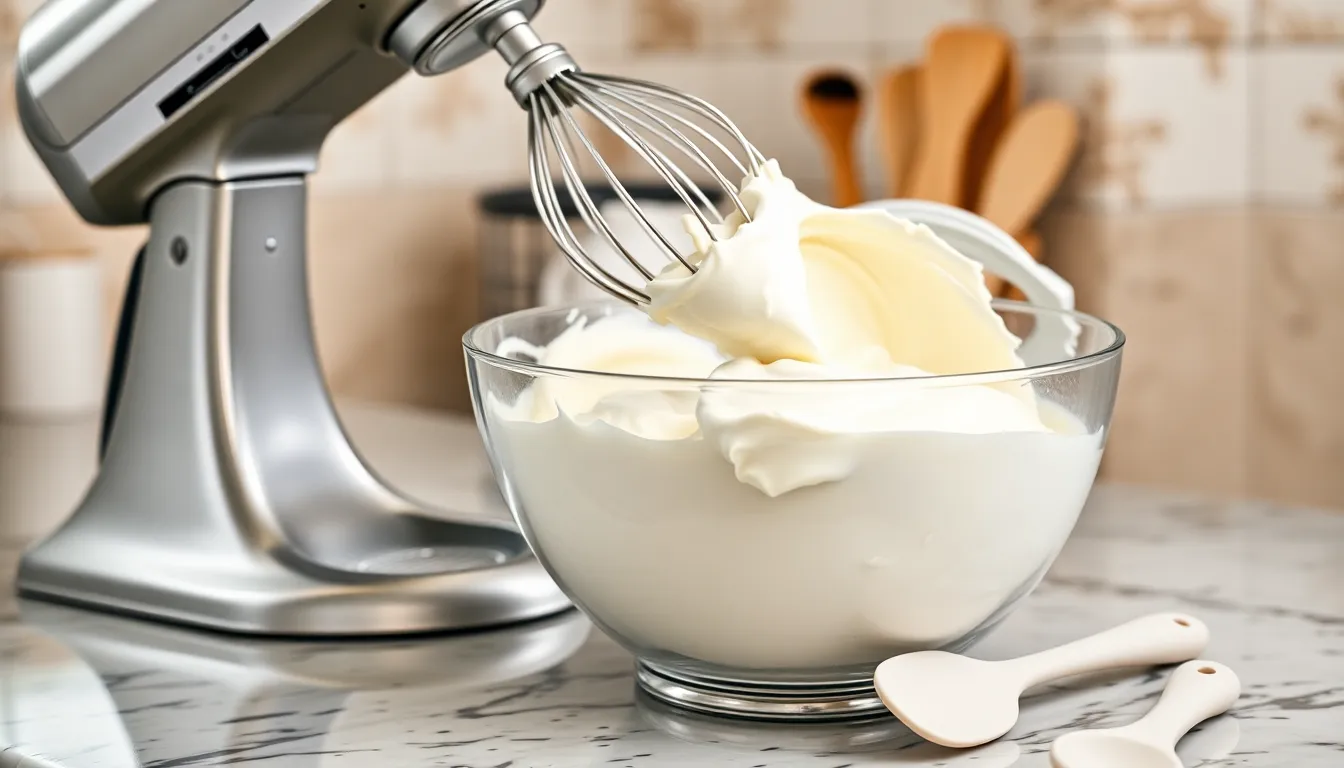
We recommend gathering the proper equipment before starting to ensure our mascarpone frosting achieves its signature smooth and creamy texture. Professional results depend on using the right tools that maintain the delicate consistency of this luxurious Italian-inspired frosting.
A large mixing bowl serves as our primary workspace and should be chilled beforehand for optimal stability. Cold bowls help maintain the cream’s structure and prevent the mascarpone from becoming too warm during mixing.
Our stand mixer or hand mixer with whisk attachment provides the necessary power to incorporate ingredients smoothly without overworking the delicate mascarpone. The whisk attachment creates the perfect amount of aeration while maintaining the frosting’s silky consistency.
A rubber spatula becomes essential for scraping down the sides of the bowl throughout the mixing process. This tool ensures all ingredients blend evenly and prevents pockets of unmixed mascarpone or powdered sugar from remaining in our finished frosting.
These three key pieces of equipment work together to create the ideal environment for producing bakery-quality mascarpone frosting. Each tool plays a exact role in achieving the perfect balance between lightness and stability that makes this frosting so versatile for piping and spreading.
Instructions
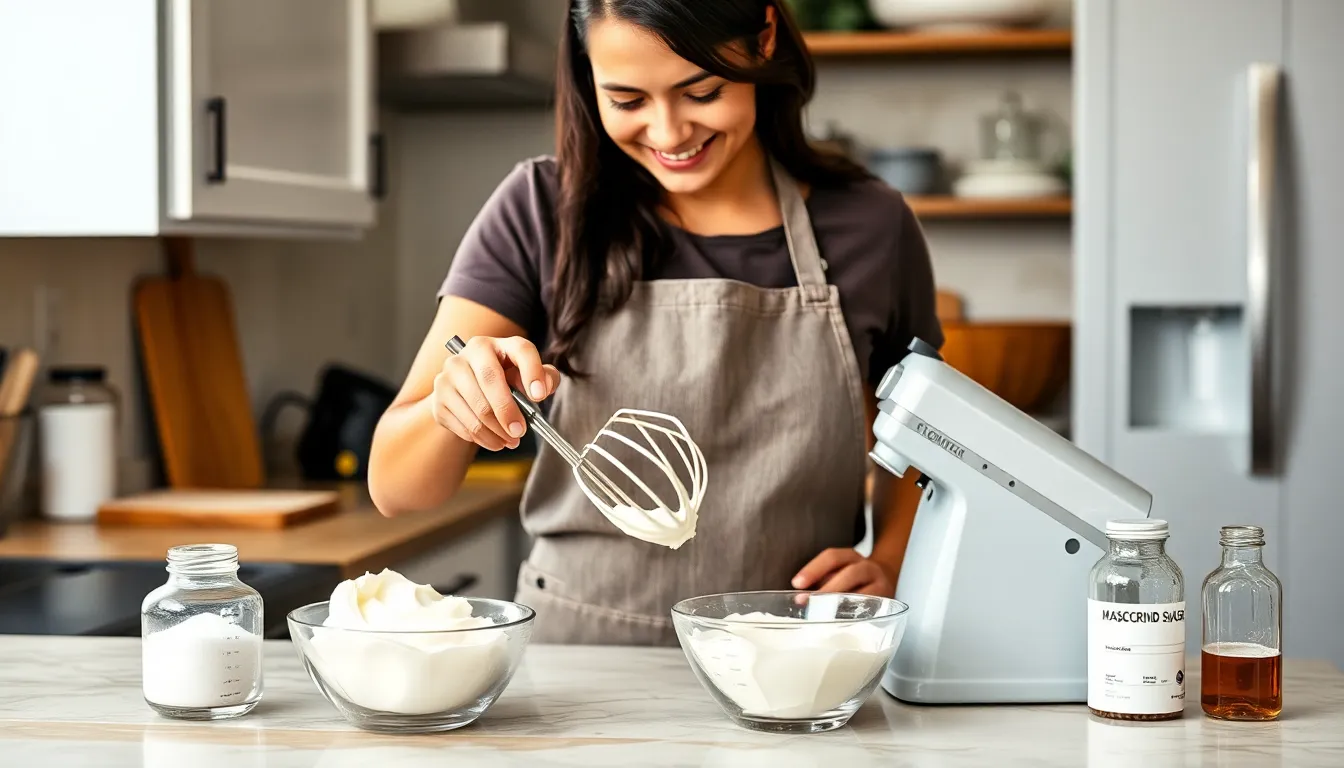
Creating our silky mascarpone frosting requires careful attention to mixing technique and temperature control. We’ll walk through each step to ensure perfect results every time.
Step 1: Prepare Your Ingredients
Remove our 8 oz mascarpone cheese from the refrigerator 30 minutes before mixing to bring it to room temperature. Measure out 1 cup powdered sugar and 2 teaspoons vanilla extract into separate bowls. Keep our 1 cup heavy cream chilled in the refrigerator until we’re ready to use it. Chill our large mixing bowl in the freezer for 10 minutes to maintain optimal temperature during mixing.
Step 2: Whip the Mascarpone
Place the room temperature mascarpone into our chilled mixing bowl. Add the vanilla extract and a pinch of salt to the mascarpone. Beat the mixture using an electric mixer on medium speed for 1-2 minutes until smooth and creamy. This aerates the mascarpone and ensures all initial ingredients blend seamlessly without lumps.
Step 3: Add Sweetener and Flavorings
Reduce our mixer speed to low before gradually adding the powdered sugar in three separate additions. Mix each addition until just combined before adding the next portion to prevent sugar from flying out of the bowl. Once all sugar is incorporated increase the speed to medium and beat for another 30 seconds to ensure the sugar fully dissolves into the mascarpone base.
Step 4: Achieve Perfect Consistency
Pour the chilled heavy cream into the mixture while mixing on low speed. Drizzle the cream slowly in a steady stream to prevent the mixture from separating. Once all cream is added increase the mixer speed to medium-high and whip for 2-3 minutes until the frosting becomes light and fluffy. Stop mixing immediately when soft peaks form to avoid overcurdling the delicate mascarpone. If the frosting does curdle add 1-2 tablespoons of cold cream and mix on low speed until smooth.
Tips for Perfect Mascarpone Frosting

Mastering mascarpone frosting requires attention to key details that separate professional results from amateur attempts. We’ve discovered that following these essential tips ensures consistently smooth and luxurious frosting every time.
Keep ingredients properly chilled to maintain the ideal consistency throughout the mixing process. Cold heavy cream prevents the mascarpone from warming too quickly while a chilled mixing bowl maintains structural integrity. Mascarpone should reach room temperature before mixing but the bowl and cream must stay cold.
Avoid overmixing at all costs since this delicate cheese can curdle or separate when worked too vigorously. We recommend mixing on low to medium speeds and stopping immediately once the frosting reaches light and fluffy consistency. Overmixed mascarpone becomes grainy and loses its signature smoothness.
Use cold ingredients strategically by ensuring both mascarpone and heavy cream remain properly chilled before combining. Room temperature mascarpone blends more easily while cold cream whips to the perfect texture without breaking down the cheese’s structure.
Adjust consistency gradually by adding ingredients in small increments rather than large amounts. More powdered sugar creates thicker frosting while additional heavy cream produces lighter texture. We suggest making adjustments one tablespoon at a time until reaching desired consistency.
Fix curdling immediately by stopping the mixer and gradually incorporating more cold heavy cream while mixing on the lowest speed setting. This technique helps restore smooth texture by rebalancing the fat content and cooling the mixture. Patient low speed mixing allows the ingredients to re-emulsify properly.
Temperature control remains the most critical factor in achieving professional results with this elegant Italian inspired frosting.
Flavor Variations
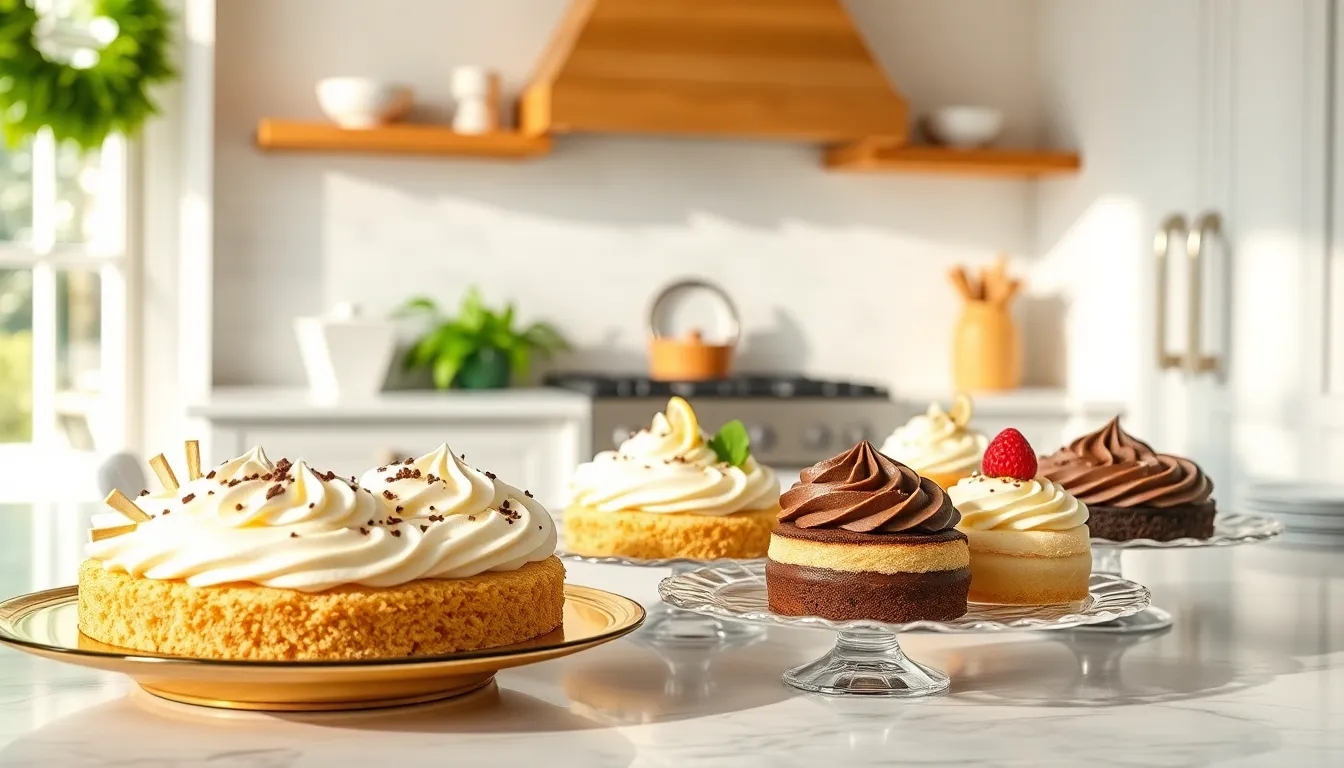
Transform our basic mascarpone frosting into exciting flavor profiles that complement any dessert perfectly. Each variation maintains the signature creamy texture while adding distinctive tastes that elevate your baking.
Vanilla Mascarpone Frosting
We enhance the classic mascarpone base by incorporating 2 teaspoons of pure vanilla extract during the final mixing stage. This version creates a light and fluffy texture that pairs beautifully with vanilla cakes and fruit desserts. Beat the mascarpone cheese with confectioners’ sugar first, then add the heavy cream and vanilla extract gradually until the mixture reaches the perfect consistency. The vanilla adds depth without overwhelming the delicate mascarpone flavor, making this our most versatile variation for wedding cakes and layered desserts.
Chocolate Mascarpone Frosting
Rich chocolate transforms our mascarpone frosting into an indulgent treat perfect for chocolate-based desserts. We add 1/4 cup of unsweetened cocoa powder to the confectioners’ sugar before mixing, or incorporate 2 ounces of melted and cooled dark chocolate during the final stages. The cocoa powder method creates a lighter chocolate flavor, while melted chocolate produces a more intense, luxurious taste. Both techniques maintain the smooth, creamy texture that makes mascarpone frosting so appealing to professional bakers.
Lemon Mascarpone Frosting
Bright citrus notes create a refreshing twist that’s perfect for spring desserts and summer celebrations. We incorporate the zest of 2 large lemons and 2 tablespoons of fresh lemon juice into our base recipe. Add the lemon zest with the confectioners’ sugar to distribute the oils evenly, then include the juice gradually to prevent curdling. This variation offers a bright and citrusy flavor that complements berry desserts and light vanilla cakes without masking the mascarpone’s subtle richness.
Coffee Mascarpone Frosting
Espresso creates a sophisticated mocha flavor that’s ideal for coffee-themed desserts and tiramisu-inspired treats. We dissolve 2 tablespoons of instant coffee powder or espresso powder in 1 tablespoon of hot water, then cool completely before adding to the mascarpone mixture. This method ensures even distribution without creating lumps or affecting the frosting’s temperature. The coffee variation pairs exceptionally well with chocolate cakes and provides the perfect balance of bitter and sweet that coffee lovers crave.
Storage Instructions
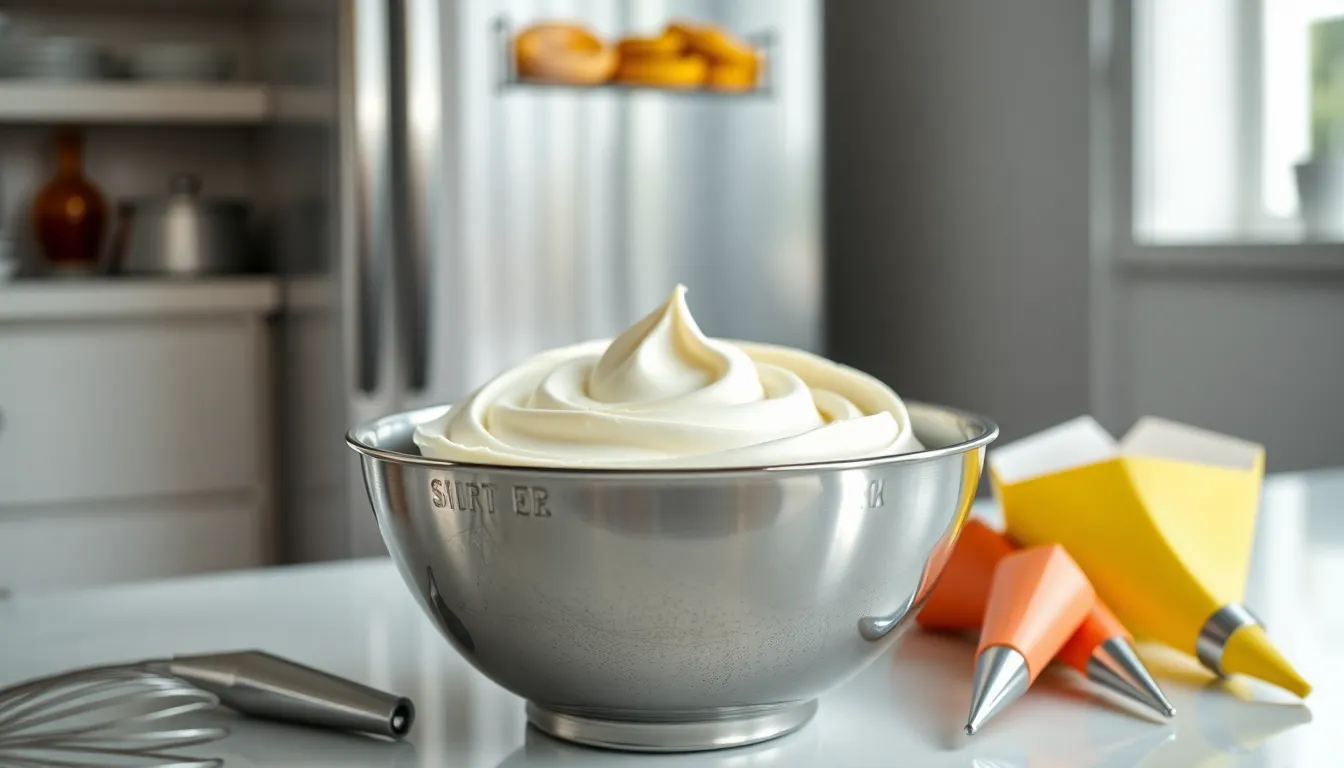
Proper storage keeps our mascarpone frosting fresh and maintains its luxurious texture for days. We recommend storing the frosting in an airtight container in the refrigerator where it stays fresh for up to 5 days according to food safety guidelines.
Refrigeration Guidelines
Our mascarpone frosting performs best when kept consistently cold. Store it in the refrigerator at 40°F or below to maintain food safety and texture integrity. The high dairy content in mascarpone requires careful temperature control to prevent spoilage.
| Storage Method | Duration | Temperature |
|---|---|---|
| Refrigerator | Up to 5 days | 40°F or below |
| Room temperature | Maximum 3 hours | Not recommended |
| Whipped cream variety | Up to 3 days | 40°F or below |
Room Temperature Limitations
We never recommend leaving mascarpone frosting at room temperature for more than 3 hours. The rich dairy content creates an environment where bacteria can multiply rapidly in warmer conditions. Always return leftover frosting to the refrigerator promptly after decorating or serving.
Restoring Texture After Storage
Chilled mascarpone frosting may firm up during refrigeration. We suggest removing it from the refrigerator 15 minutes before use to soften slightly. If the texture appears separated or too firm after storage we can restore its original consistency by re-whipping briefly with a mixer on low speed.
Freezing Considerations
We do not recommend freezing mascarpone frosting as it becomes grainy and loses its smooth texture when thawed. The delicate emulsion breaks down during the freezing process making the frosting unsuitable for decorating. Fresh preparation always yields the best results for our mascarpone frosting projects.
Optimal Usage Timeline
For best decorating results we recommend using mascarpone frosting on the same day it’s made or within 24 hours. The frosting pipes most smoothly and holds its shape best during this timeframe. While it remains safe to eat for up to 5 days the texture gradually becomes less ideal for detailed piping work.
Best Uses for Mascarpone Frosting

Our luxurious mascarpone frosting shines across many dessert applications thanks to its versatile texture and mild flavor profile. We’ve discovered that this Italian-inspired frosting works exceptionally well as both a decorative element and functional component in various sweet treats.
Cakes and Cupcakes
We recommend mascarpone frosting as our go-to choice for topping and decorating cakes and cupcakes. The frosting spreads smoothly across surfaces while maintaining enough structure for intricate piping work. Our fluffy yet sturdy consistency allows us to create beautiful rosettes, borders, and decorative shapes that hold their form throughout serving. Wedding cakes particularly benefit from this frosting’s elegant appearance and professional finish.
Layer Filling Applications
Between cake layers, our mascarpone frosting provides the perfect balance of richness and lightness. We find it stable enough to support multiple tiers without compromising structural integrity. The creamy texture creates a luxurious contrast against tender cake crumbs while allowing the cake’s flavors to shine through. Lemon mascarpone cake layers showcase this application beautifully.
Cheesecake and Pie Enhancement
As a finishing touch for cheesecakes and pies, we use mascarpone frosting to add visual appeal and textural interest. The light consistency complements dense cheesecake bases without overwhelming the palate. Our frosting creates an elegant crown on fruit pies and tarts, providing a creamy counterpoint to tart fillings.
Creative Dessert Fillings
We’ve successfully incorporated mascarpone frosting as filling in various dessert constructions. Between blueberry shortcake biscuits, the frosting creates a sophisticated twist on the classic dessert. Layered parfaits benefit from our frosting’s ability to maintain structure while providing creamy indulgence between fruit and cake components.
Versatile Dipping Options
Our mascarpone frosting transforms into an elegant dip for fresh fruit platters and graham crackers. We serve it as a lighter alternative to traditional cream-based dips at gatherings. The mild sweetness pairs exceptionally well with strawberries, grapes, and crisp apple slices.
Cream Cheese Frosting Alternative
We frequently substitute our mascarpone frosting for cream cheese frosting on banana bars, brownies, and red velvet cakes. The less tangy profile creates a more refined flavor experience while maintaining the desired creamy texture. Our frosting provides the richness expected from traditional options without overpowering delicate cake flavors.
| Application | Key Benefits |
|---|---|
| Cake/Cupcake Decoration | Holds piping shapes, smooth spreading |
| Layer Filling | Structural stability, light texture |
| Cheesecake Topping | Elegant finish, balanced sweetness |
| Dessert Filling | Versatile consistency, flavor enhancement |
| Fruit Dip | Light alternative, sophisticated pairing |
| Frosting Substitute | Less tangy, refined flavor profile |
Before using refrigerated mascarpone frosting, we recommend allowing it to sit at room temperature for approximately 10 minutes. This brief warming period ensures optimal spreading consistency and makes piping work effortless. Our frosting maintains its quality when stored properly in airtight containers for up to 4 days in the refrigerator.
Troubleshooting Common Issues

Even with careful preparation, mascarpone frosting can present challenges during the mixing process. We’ve compiled the most common problems and their answers to help you achieve perfect results every time.
Curdling and Separation
Temperature differences between ingredients cause the most frequent issues with mascarpone frosting. When mascarpone sits at room temperature while heavy cream remains cold, the mixture can curdle during combining. We recommend bringing all ingredients to the same temperature before mixing to prevent this separation.
If curdling occurs during preparation, gently warm the entire mixture by placing the bowl over a warm water bath for 30 seconds. Remove from heat and mix on low speed until the texture becomes smooth again. This method helps even out temperature differences without overheating the delicate mascarpone.
Splitting During Mixing
Overmixing creates another common problem that causes the frosting to split and lose its creamy consistency. We suggest monitoring the mixture closely as you blend ingredients together. Stop mixing immediately when the frosting reaches the desired consistency to avoid overworking the mascarpone.
When splitting occurs, try adjusting the temperature slightly by cooling or warming the mixture. Add one tablespoon of cold heavy cream while mixing on the lowest speed setting. This technique often brings the frosting back together without compromising its texture.
Consistency Problems
Runny frosting typically results from over-whipping or adding too much liquid during preparation. We recommend adding more mascarpone cheese one tablespoon at a time until the mixture reaches the proper thickness for spreading and piping.
Overly stiff frosting usually indicates under-whipping or excessive powdered sugar. Incorporate additional heavy cream gradually while mixing on medium speed. Add cream one teaspoon at a time until you achieve the desired consistency.
Melting and Sliding Issues
Mascarpone frosting can melt or slide off desserts when applied to warm surfaces. We always ensure cakes and cupcakes cool completely to room temperature before frosting application. This cooling period prevents the frosting from losing its structure.
For additional stability, refrigerate the finished frosting for 15 minutes before use. This chilling period firms up the texture and makes piping decorations much easier to control.
| Problem | Cause | Solution |
|---|---|---|
| Curdling | Temperature differences between ingredients | Ensure all ingredients at same temperature; warm mixture gently if needed |
| Splitting | Overmixing or temperature differences | Monitor consistency closely; add cold cream gradually |
| Too Runny | Over-whipping or excess liquid | Add mascarpone one tablespoon at a time |
| Too Stiff | Under-whipping or excess sugar | Add heavy cream one teaspoon at a time |
| Melting/Sliding | Warm cake surface | Cool desserts completely; refrigerate frosting before use |
Make-Ahead Instructions
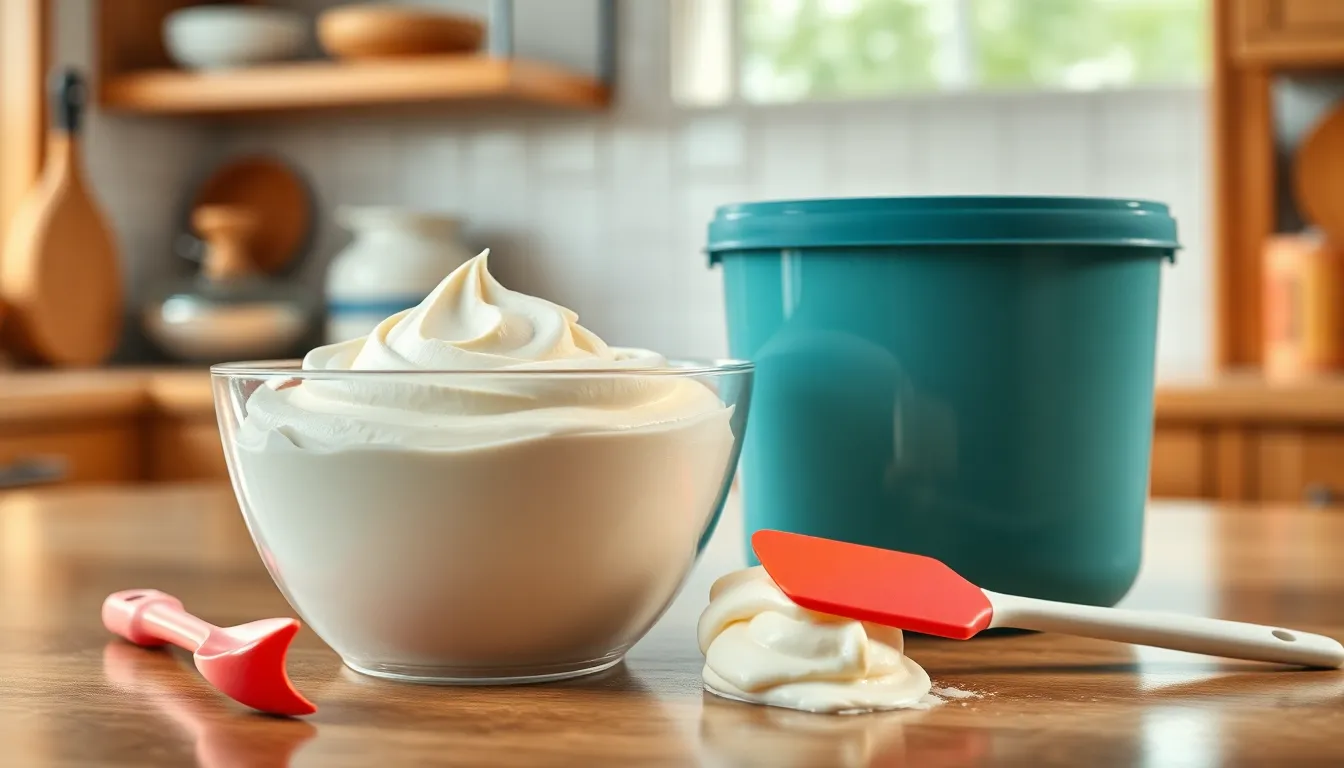
Planning ahead transforms our baking routine from stressful to seamless when we prepare mascarpone frosting in advance. This luxurious frosting maintains its creamy texture and rich flavor when stored properly, making it an ideal candidate for meal prep and event planning.
We can prepare mascarpone frosting up to 2 days ahead and store it in the refrigerator without compromising quality. The frosting should be transferred to an airtight container immediately after preparation to prevent absorption of refrigerator odors and maintain optimal texture. Our testing shows that properly stored mascarpone frosting retains its smooth consistency throughout this storage period.
| Storage Method | Duration | Container Type | Temperature |
|---|---|---|---|
| Refrigeration | Up to 2 days | Airtight container | 35-40°F |
| Freezing | Up to 1 month | Freezer-safe container | 0°F |
Refrigeration storage requires placing the frosting in a clean, airtight container and positioning it in the main body of the refrigerator rather than the door. We recommend placing plastic wrap directly on the surface of the frosting before sealing the container to create an additional moisture barrier.
Freezing extends storage to one month when we need longer preparation time. The frosting should be portioned into smaller containers for easier thawing and use. When ready to use frozen frosting, we transfer it to the refrigerator 24 hours before needed, allowing gradual thawing that preserves texture integrity.
Reactivating stored frosting involves bringing it to room temperature for 15-20 minutes before use. The frosting may appear slightly firm after refrigeration, but gentle re-whipping with a mixer for 30-60 seconds restores its original light and fluffy consistency. We avoid aggressive mixing during reactivation to prevent breaking the delicate mascarpone structure.
Quality indicators help us determine if stored frosting remains suitable for use. Fresh mascarpone frosting should maintain its pale color, smooth texture, and mild sweet aroma throughout the storage period. Any signs of separation, off odors, or color changes indicate the frosting should be discarded rather than used.
Conclusion
We’ve shown you how to create bakery-quality mascarpone frosting that’ll transform your desserts into elegant masterpieces. This Italian-inspired frosting offers the perfect balance of richness and sophistication while remaining surprisingly simple to make.
With our step-by-step guide temperature control tips and flavor variations you’re now equipped to create professional-level desserts at home. Whether you’re frosting a wedding cake or adding a luxurious touch to cupcakes this versatile frosting delivers consistent results.
Remember that practice makes perfect with mascarpone frosting. Start with our basic recipe master the technique and then experiment with the exciting flavor combinations we’ve shared. Your desserts will never be the same again.
Frequently Asked Questions
What is mascarpone frosting and how is it different from buttercream?
Mascarpone frosting is a luxurious Italian frosting made with mascarpone cheese, powdered sugar, and heavy cream. Unlike traditional buttercream, it’s less sweet, has a silky smooth texture, and offers a mild flavor that complements rather than overpowers desserts. It’s creamier than cream cheese frosting without the tanginess.
What ingredients do I need to make mascarpone frosting?
You only need five simple ingredients: mascarpone cheese, powdered sugar, heavy whipping cream, vanilla extract, and an optional pinch of salt. Make sure the mascarpone is at room temperature and the heavy cream is chilled for best results.
Can I substitute mascarpone cheese if I can’t find it?
Yes, you can substitute mascarpone with cream cheese, sour cream, or Greek yogurt, plus an increased amount of heavy cream to maintain consistency. However, the flavor will be slightly tangier than traditional mascarpone frosting.
How long can I store mascarpone frosting?
Store mascarpone frosting in an airtight container in the refrigerator for up to 5 days. Don’t leave it at room temperature for more than 3 hours due to food safety concerns. Avoid freezing as it can lose its smooth texture.
What should I do if my mascarpone frosting curdles?
If your frosting curdles, it’s usually due to temperature differences. Add more cold heavy cream while mixing on low speed to restore smoothness. Make sure all ingredients are at similar temperatures before mixing to prevent this issue.
What are some popular flavor variations for mascarpone frosting?
Popular variations include vanilla (with extra vanilla extract), chocolate (with cocoa powder or melted chocolate), lemon (with lemon zest and juice), and coffee (with espresso). Each maintains the signature creamy texture while adding unique flavors.
Can I make mascarpone frosting ahead of time?
Yes, you can make mascarpone frosting up to 2 days ahead. Store it in the refrigerator in an airtight container. Before using, let it come to room temperature for about 15 minutes and gently re-whip to restore the original consistency.
What desserts work best with mascarpone frosting?
Mascarpone frosting is perfect for cakes, cupcakes, cheesecakes, and pies. It’s also excellent as a layer filling for cakes, a dip for fresh fruit, or as a refined alternative to cream cheese frosting in various baked goods.

